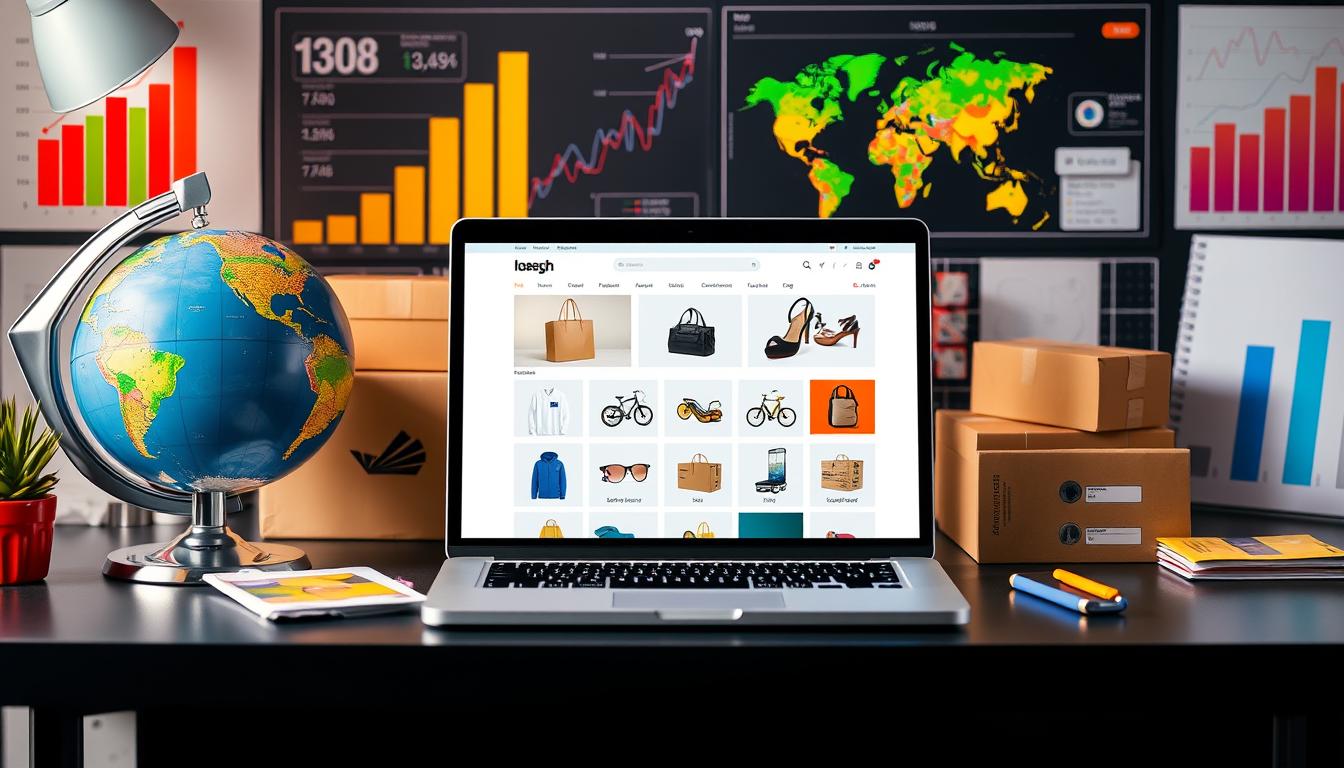I’m thrilled to share with you the ultimate guide to starting a dropshipping business. Dropshipping is a great way to start a business with little money upfront. It’s perfect for those with marketing skills1. You don’t need to keep any products in stock. Instead, the supplier sends them directly to your customers, saving you money1.
In this guide, I’ll show you nine important steps to start your own dropshipping business. We’ll cover finding a profitable niche, reliable suppliers, setting up an online store, and marketing. I’ll give you all the knowledge and tools you need to make your business dream come true2.
Key Takeaways
- Dropshipping is a low-risk business model that requires minimal upfront investment.
- Choosing the right supplier is crucial for the success of a dropshipping business.
- Competitor analysis and product research are essential for identifying profitable niches.
- Establishing a strong online store and brand identity is key to standing out in the market.
- Effective marketing strategies, including SEO and social media, can drive traffic and sales.
What is Dropshipping?
Dropshipping is a way for businesses to sell lots of products without keeping any in stock3. When a customer buys something, the store buys it from a supplier, who then sends it to the customer3. It’s great for new businesses because it’s easy to start and can grow quickly4.
Definition of Dropshipping
Dropshipping means the seller doesn’t keep products in stock. Instead, they send orders to a supplier, who ships the product to the customer3.
How Dropshipping Works
When a customer buys something, the seller sends the order and payment to the supplier. The supplier then ships the product to the customer, without the seller needing to get involved3.
Benefits of Dropshipping
Dropshipping has many benefits. It saves money on warehouse space and inventory management3. It also lets sellers test new products without buying a lot of stock, making it efficient for handling lots of orders3.
But, it can mean lower profits because of more competition and less money spent upfront3. Also, shipping from overseas can take longer, which might upset customers3. Sellers also have to deal with customer service issues like delayed shipments and returns3.
| Benefit | Description |
|---|---|
| Low Startup Costs | Dropshipping requires minimal upfront investment, as the retailer doesn’t need to purchase and store inventory. |
| Scalability | Dropshipping businesses can efficiently handle a large number of orders without the constraints of physical inventory. |
| Wide Product Variety | Retailers can offer a diverse range of products without the risk of unsold inventory. |
| Flexibility | Dropshipping allows for easy testing of new product categories and quick adjustments to the product line. |
Dropshipping is a big deal in supply chain management, letting retailers sell lots of products without the usual order fulfillment problems34.
“Dropshipping generates over $300 billion in ecommerce sales annually, making it a significant force in the online retail industry.”3
The dropshipping model is getting more popular as e-commerce grows. It’s a good choice for businesses wanting to make things easier and meet the demand for quick, easy shopping4.
Choosing Your Niche
Finding the right dropshipping niche is key to your online business’s success. By focusing on a specific market, you can tailor your products and marketing to meet your audience’s needs. Let’s look at the steps to pick the perfect niche for your dropshipping business.
Understanding Market Demand
Start by analyzing market demand. Use Google Trends to see search interest over time and find top search terms. It also shows geographic trends and seasonality5. Also, check online marketplaces like Amazon and AliExpress for trending products. This gives you insights into what customers want5.
Researching Competitors
Doing a deep dive into your competitors is crucial. Look online, on social media, and in forums to find out what they offer. This helps you spot gaps in the market and find ways to stand out.
Evaluating Product Viability
After finding potential niches, check if the products are viable. Look at profit margins, shipping costs, and demand. Accessory-heavy niches often have higher margins because customers are less price-sensitive5. Also, niches with dedicated hobbyists can be profitable because enthusiasts spend a lot on their interests5. Trendy products that are hard to find locally can also be good, if there’s enough demand5.
| Key Considerations | Insights |
|---|---|
| Market Demand | |
| Product Viability |
“Identifying the right niche is the cornerstone of a successful dropshipping business. By thoroughly understanding market demand and competitor landscape, you can position your offerings to stand out and cater to the specific needs of your target audience.”
Finding Reliable Suppliers
Choosing the right drop shipping suppliers is key to your business’s success. With many options, it’s important to pick reliable and reputable providers7.
Platforms for Supplier Sourcing
Online platforms have vast directories of drop shipping suppliers. This makes finding and checking potential partners easier7. Inventory Source has over 230 suppliers7. Salehoo lists over 8,000 companies across 75 categories7. Worldwide Brands has more than 8,000 suppliers, but it costs $299 for full access7.
Sell The Trend offers millions of products and makes adding them to your store easy7. Oberlo and Dropified are Shopify apps that connect you with suppliers from the US and China7.
Importance of Supplier Communication
Good communication with suppliers is vital for success8. Talking directly to suppliers lets you learn about their reliability, like shipping times8. Strong relationships can also get you better prices and might let you carry your own inventory8.
Evaluating Supplier Credibility
It’s important to check a supplier’s credibility9. Look at product quality, delivery times, customer service, and their reputation8. AliExpress, DSers, and others offer a wide range of suppliers9. Ordering samples can also help you check quality8.
By choosing the right suppliers and communicating well, you can build a strong dropshipping business8.
Setting Up Your Online Store
Starting your own online store is better than using platforms like Etsy or eBay. Building your store on WordPress with WooCommerce is a great choice10. This lets you customize your store and use WooCommerce’s strong ecommerce tools.
To start, buy a WooCommerce hosting plan. Then, create key pages like your homepage and product listings. Make sure your store is easy to navigate and add your products. WooCommerce has many themes that look great and work well with the platform10.
Make sure your product pages have good descriptions, prices, and shipping info. This builds trust with your customers. Use tags and categories to help people find your products online10. Add great images and real customer reviews to make shopping better.
Selecting an E-Commerce Platform
Picking the right ecommerce platform is key for your dropshipping store11. Shopify, WooCommerce, and Magento are popular for their features and ease of use11. They help you build a strong online presence.
Designing Your Storefront
The look and feel of your store are important for attracting customers11. Use themes and templates from your platform to make your store look professional. Make sure your site works well on phones and is easy to use.
Payment Gateway Options
Choosing the right payment gateway is crucial for smooth transactions11. Look at fees, integration, and security. PayPal, Stripe, and Square are good options that work well with your store.
With careful planning, you can set up a great online store for your dropshipping business12.
Legal Considerations
Starting a dropshipping business means understanding the legal side. It’s a legal way to sell online, adapting to changes easily13. But, selling across borders can get tricky, needing you to follow different laws14.
Choosing the Right Business Structure
First, pick a legal structure for your dropshipping business. You might choose a sole proprietorship, partnership, or LLC. This choice affects your taxes, liability, and how you run your business. Talking to a lawyer can help pick the best one for you13.
Obtaining Necessary Licenses and Permits
You might need licenses and permits, depending on where you are and what you sell. Laws differ by state or country, so it’s key to check and follow them13. Not getting the right licenses can lead to legal trouble and slow your business down14.
Understanding Taxes and Regulations
Dropshipping businesses face many tax rules, like federal, state, and sales taxes. In the U.S., income tax rates are 10% to 37%, and sales taxes range from 0% to 11%15. Customs duty taxes can be 0% to 37.5% based on what you sell15. Keeping up with taxes and following the rules is vital to avoid legal problems and fines14.
| Tax Considerations for Dropshippers | United States |
|---|---|
| Federal Income Tax Rates | 10% to 37% |
| Sales Tax Rates | 0% to 11% |
| Customs Duty Taxes | 0% to 37.5% |
Dropshippers also need to watch out for laws on consumer protection, truth in ads, and email marketing14. Getting advice from lawyers and tax experts can help keep your business legal and safe13.
By understanding and following the law, dropshippers can build a solid business. This builds trust with customers and avoids legal problems14. Starting with a focus on legal compliance can give you an edge in the competitive ecommerce world13.
Crafting Your Brand
Creating a strong brand identity is key for your dropshipping business to shine in a crowded market16. The dropshipping world is open to many, but it’s also very competitive. With so many vendors, it’s important to know your customers well and find your unique spot16.
Developing a Unique Value Proposition
Having core brand values sets you apart and makes a real difference with your customers16. Your logo, colors, and fonts are crucial in connecting with people on an emotional level16. To stand out, use top-notch photos, unique names, and custom packaging for your products16.
Creating a Memorable Logo
Branding is not just about having a great logo; it’s about crafting a cohesive visual identity that resonates with your target audience.17 Tools like Hatchful can help you create a logo that shows off your brand’s identity and professionalism. This boosts recognition and keeps customers coming back17.
Building an Online Presence
Your brand voice should be relatable and match your audience for effective communication16. Make sure your products, services, and marketing fit your brand image for a unified experience16. A strong online presence through a professional site and social media helps connect with your audience and build loyalty18.
“Branding is not just about having a great logo; it’s about crafting a cohesive visual identity that resonates with your target audience.”
| Branding Strategies | Benefits |
|---|---|
| Branded Dropshipping | |
| Unbranded Dropshipping |
Building a strong brand is key for your dropshipping business to shine and connect with your audience17. By focusing on a unique value proposition, creating a memorable logo, and engaging online, you can make your brand stand out and leave a lasting impression1618.

Marketing Your Dropshipping Business
Effective digital marketing is key for your dropshipping business. It drives traffic and gets you more customers. Use social media, SEO, and email marketing to reach your audience. This boosts sales and revenue.
Leveraging Social Media
Social media like Facebook, Instagram, and TikTok are great for showing off your products. Make your content visually appealing and use popular trends and hashtags. This increases your visibility19. But, remember, success on social media takes consistent effort19.
Understanding SEO
Make your online store and product listings search engine friendly. This means writing good product descriptions and creating valuable blog content20. AI tools like ChatGPT can help make SEO-optimized articles quickly20.
Email Marketing Strategies
Use email marketing to keep in touch with your customers and encourage them to buy again. Send out a newsletter with updates, offers, and valuable content19. Make sure your emails are both beautiful and informative to get better results19.
By using these digital marketing strategies, you can attract new customers to your dropshipping business. It’s important to track how well your marketing works and make changes based on the data. This helps you get the most out of your marketing efforts.
Managing Customer Service
Great customer service is key to a successful dropshipping business. Setting up good systems for handling customer questions and clear return and refund policies boosts satisfaction. This leads to more repeat business21.
Importance of Customer Support
Quick and helpful responses to customer questions are vital. Offer different ways to communicate, like email, phone, and live chat. This meets your customers’ needs22.
Tools for Managing Inquiries
Use tools like help desk software or chatbots to manage customer inquiries. They offer fast and consistent answers. This lets you focus on other business tasks2122.
Handling Returns and Refunds
Make sure your return and refund policies are clear and fair. They should match your suppliers’ rules. Train your team well to handle any issues quickly and professionally22.
Good customer service builds a loyal customer base. It also boosts your business overall23.
| Key Strategies for Effective Customer Service | Benefits |
|---|---|
|
|

“Excellent customer service is crucial for building a successful dropshipping business. Implement efficient systems and develop clear policies to enhance customer satisfaction and encourage repeat business.”
By focusing on customer service, you can gain a loyal customer base. This improves your business overall23.
Analyzing Business Performance
As a thriving dropshipping entrepreneur, it’s crucial to regularly analyze your business’s performance. This helps identify opportunities for growth and optimization. By tracking essential metrics and using powerful analytics tools, you can steer your dropshipping venture towards greater success and profitability.
Tracking Essential Metrics
Key Performance Indicators (KPIs) are specific metrics used to measure business success objectively24. Optimizing these KPIs can lead to improved profits by identifying areas for improvement24. Monitoring KPIs allows for data-driven decision-making and swift adaptation to market trends24. Essential metrics to track include conversion rate, average order value (AOV), customer acquisition cost (CAC), and customer lifetime value (CLV).
Using Analytics Tools
Leverage powerful analytics tools like Google Analytics and your e-commerce platform’s built-in analytics to gather data25. These analytics provide valuable insights, allowing you to make informed decisions about product selection, pricing strategies, and marketing efforts25. Utilize features like traffic and conversion metrics, sales and revenue analytics, and customer behavior analysis to optimize your dropshipping business25.
Making Data-Driven Decisions
Regularly review and analyze the data from your performance metrics and analytics tools24. Use these insights to adjust your business strategies, fine-tune your product offerings, and refine your marketing approach24. By basing your decisions on concrete data rather than assumptions, you can enhance the overall performance and profitability of your dropshipping venture24.
“Successful dropshipping businesses are built on a foundation of data-driven decision-making. Understanding your key performance metrics is the first step towards sustainable growth and profitability.”
| Performance Metric | Description | Importance |
|---|---|---|
| Conversion Rate | The percentage of website visitors who complete a purchase | Measures the effectiveness of your website, product offerings, and marketing strategies |
| Average Order Value (AOV) | The average amount spent by customers per order | Influences pricing strategies and customer retention efforts |
| Customer Acquisition Cost (CAC) | The total cost of acquiring a new customer | Informs the effectiveness of your marketing campaigns and customer acquisition channels |
| Customer Lifetime Value (CLV) | The predicted future revenue from a customer | Helps identify valuable customers and target them with personalized marketing |
By consistently monitoring your performance metrics and leveraging business analytics, you’ll be well on your way to making informed decisions. These decisions drive the growth and profitability of your dropshipping business2425.
Scaling Your Dropshipping Business
As your dropshipping business grows, it’s time to explore opportunities for scaling. Look for new product lines or niches that fit well with what you already offer. These can attract a wider audience26. Also, expanding to new markets or platforms can help you reach more customers worldwide and build your brand26.
To handle more traffic and sales, use automation tools for tasks like order fulfillment and inventory management26. These tools can save you time and let you focus on making your business better and improving customer service26.
Always work on making your website and customer service better to keep customers coming back27. Remember, 84% of shoppers value good customer service when buying, and 75% prefer talking to a real person over a chatbot27. Also, think about hiring virtual assistants or employees to help with the extra work as your business grows26.
FAQ
What is dropshipping?
How does the dropshipping process work?
What are the benefits of starting a dropshipping business?
How do I choose a profitable dropshipping niche?
Where can I find reliable dropshipping suppliers?
How do I set up an online store for my dropshipping business?
What legal considerations do I need to keep in mind?
How can I effectively market my dropshipping business?
What customer service best practices should I follow?
How do I analyze the performance of my dropshipping business?
How can I scale my dropshipping business?
Source Links
- How to start dropshipping in 2024 – a practical guide – https://www.hostinger.com/tutorials/how-to-start-dropshipping-business
- How To Start a Dropshipping Business: 9-Step Guide (2025) – Shopify – https://www.shopify.com/blog/how-to-start-dropshipping
- What Is Dropshipping and How Does It Work? (2025) – Shopify – https://www.shopify.com/blog/what-is-dropshipping
- What Is dropshipping? How does it work in 2024? – https://sell.amazon.com/learn/what-is-dropshipping
- How To Find the Best Dropshipping Niches in 2024 – Shopify – https://www.shopify.com/blog/dropshipping-niches
- Best dropshipping niches to grow your business in 2024 – https://www.gelato.com/blog/profitable-dropship-niches
- How To Find (& get approved with) Dropship Suppliers – https://www.inventorysource.com/dropshipping/how-to-find-dropship-suppliers/
- Council Post: How To Find Dropshipping Suppliers – https://www.forbes.com/councils/forbesbusinesscouncil/2021/12/06/how-to-find-dropshipping-suppliers/
- 14 Best Dropshipping Suppliers in 2025 – Shopify – https://www.shopify.com/blog/dropshipping-suppliers
- How to Dropship on Shopify (2025) – Shopify – https://www.shopify.com/blog/dropshipping-guide
- How to Start a Successful Dropshipping Business: A Comprehensive Guide – https://www.investopedia.com/start-dropshipping-business-7972886
- How To Start Dropshipping: A Detailed Step-by-Step Guide (2024) – https://www.oberlo.com/blog/how-to-start-a-dropshipping-business
- Is Dropshipping Legal? A Guide to the Legal Risks (2025) – Shopify – https://www.shopify.com/blog/is-dropshipping-legal
- Is Dropshipping Legal? 5 Requirements To Run A Legit Operation – https://www.sparkshipping.com/blog/is-dropshipping-legal
- Is Dropshipping Legal? Requirements, Legal Risks, and More – https://easync.io/articles/is-dropshipping-legal/
- How to Build a Brand for Your Dropshipping Store | Entrepreneur – https://www.entrepreneur.com/leadership/how-to-build-a-brand-for-your-dropshipping-store/371716
- Branded Dropshipping – New Step by Step Updated Guide – https://www.autods.com/blog/dropshipping-tips-strategies/branded-dropshipping/
- Branded Dropshipping: Elevating Your E-commerce Strategy – https://www.swagify.com/blog/branded-dropshipping/?srsltid=AfmBOorTG5ERsvey8_qNsf-JdmbF6eF5JVerXzDuC9vM7Mn3zbfFHDZi
- Marketing for Dropshipping | How To Get Free Traffic To Your Dropshipping Store – https://debutify.com/blog/12-effective-ways-to-get-free-traffic-to-your-dropshipping-store
- 10 Profitable Dropshipping Marketing Strategies For 2024 – https://blog.dropcommerce.com/posts/dropshipping-marketing-strategies
- Tips for Excellent Customer Service As a Dropshipper – https://www.inventorysource.com/tips-for-excellent-customer-service-as-a-dropshipper/
- Customer Service For Dropshipping: 9 Customer Service Tips – https://www.bluecart.com/blog/customer-service-dropshipping
- How do you handle customer service for your dropshipping store? – https://www.linkedin.com/advice/1/how-do-you-handle-customer-service-your-dropshipping
- Essential KPIs for Tracking Dropshipping Business Profitability – https://www.inventorysource.com/essential-kpi-for-tracking-dropshipping-sucess/
- Drop Shipping Analytics: Maximizing Profitability Through Data Insights – Matellio Inc – https://www.matellio.com/blog/drop-shipping-analytics/
- How to Scale a Dropshipping Business in 2023: The Ultimate Guide – https://nichedropshipping.com/how-to-scale-dropshipping-business/
- Scale Without Fail: 6 Steps To Grow Your Dropshipping Business – https://www.sparkshipping.com/blog/6-steps-to-grow-your-dropshipping-business


